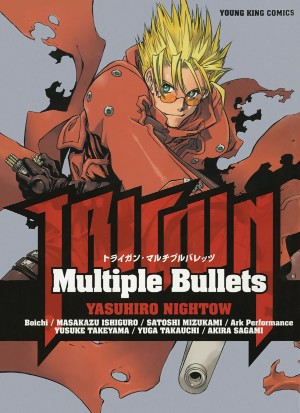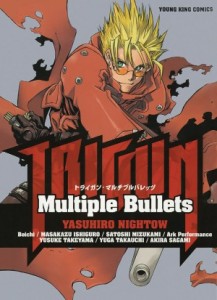By Various Artists, series created by Yasuhiro Nightow. Released in Japan by Shonen Gahosha direct to tankobon. Released in North America by Dark Horse.
I am generally a manga person, though I have a lot of anime that I love. But if you were to ask me which I preferred, the manga or the anime, 90% of the time I would pick the former. Trigun is one of those exceptions, however. I saw the anime first, and was entertained and riveted by its over the top action and comedy slowly wending its way towards inevitable tragedy. It, like many other Shonen Gahosha series (including Hellsing and Excel Saga) was licensed for an anime very early on in its run, so had an ending that had many of the same beats the author wanted but was distinctly different. Unfortunately, Nightow’s action scenes tend to leave me hopelessly confused, as I simply can’t follow what he’s drawing half the time. His storytelling is also very oblique (typical to a Western). As such, I never really got into Trigun Maximum.
But I picked up this anthology anyway, as I was curious to see what other writers would do with Nightow’s vision. Of course, what most people might pick this up for is Nightow himself – it contains the 80-page story he wrote up to go with the release of the Trigun movie. The story, Badlands Rumble, is pretty much an encapsulation of the manga. Meryl and Milly are there but don’t do anything, Vash is really silly and then not so much, Wolfwood gets irritated but clearly is siding with Vash, and there are innocents and villains who are out of Bob’s Big Book of Western Cliches. If you liked Trigun, you’ll get a kick out of it.
Of the remaining stories, there were two that didn’t really work for me. Boichi’s story about a woman giving birth to an atomic bomb – sort of – and plays on Vash’s pledge to avoid killing. It is, however, filled with Boichi’s fanservice (he writes Sun-Ken Rock), something Trigun is usually blissfully free of. And the 4-koma with Meryl and Milly is really, really slight and not all that funny.
But there’s also some excellent storytelling here. The folks who worked on this anthology love to play around in Nightow’s world, rather than just writing character-based stories about Vash. Satoshi Mizukami, who does my pet favorite The Lucifer and Biscuit Hammer, has a story about whether the various warring races (humans, plants, worms) can really come together, but it’s actually cuter than I make it sound. Yusuke Takeyama’s is dark and depressing, with another typical Western cliche: the bit of hope that is then brutally cut down. That said, it’s tense, gripping stuff. And Sagami Akira’s Vash/Meryl story about the impossibility that is Vash’s hair is really shippy in exactly the same way that the Trigun manga never is. (The anime was a bit better at it.)
And easily the gold standard in this collection is the storybook tale that retells Trigun as a fairy tale, written by Ark Performance (better known for their Gundam stuff). The art is fantastic, the style is gorgeous, and the reveal of who’s telling the story is the perfect sweet (and bittersweet) capper. The entire volume is worth getting just for this 16-page story.
I generally prefer character-driven works to world-building stories, and Trigun definitely falls into the latter category. That said, many writers love walking around in someone else’s world, and Nightow’s is probably one of the best to wade into. This anthology had more hits than misses, and is a good epilogue to the Trigun series.


Someone else with the same opinion on Trigun anime vs manga as me! Yeah, I loved the anime’s balance between action and silly, but the manga artwork was simply unfollowable. I like to think I’m not stupid at reading action manga, but I now realize it simply has to be drawn well in the first place, like Kekkaishi or Firefighter Daigo. Trigun’s action scenes are just pure mess, and it’s mostly action scenes it seems, makes the manga so painful for me. So I’ll continue to enjoy the anime! I also liked the movie, basically an extra long episode, but wasn’t that exactly what I wanted in this case?
You may say it’s worth buying for those 16 pages, and A Drunken Dream certainly was for Hanshin so I now never doubt the power of so few pages, but I think I’ll go to the library first on this one.
Well I love the manga at least 10 times more than the anime.and the anime was one of my very first but I always felt it was incomplete(because it was)). The anime turned Vash into one of the greatest of heroes. The manga, however, took that hero and gave him an innate beauty and spiritual grandeur that, for me, is unsurpassed. Regarding Nightow’s drawing style for battle scenes….battle, true battle, is absolute chaos and would be hard to follow to the casual viewer. I, for one, find it to be a perfect fit for the series. Also the manga turns Knives into a perfect well intentioned extremist villain and gives him a real threatening presence, making him much more than the vague behind-the-scenes danger he is in the anime. The manga has more action, more excitement, more drama, more love, more philosophy, more humanity and proves that, no matter what happens, the bonds between us can be strained but never severed.
It was great to see what the different manga writers and artists brought to the table that is Trigun in Multiple Bullets. The first story is, of course, a great epilogue to the movie. I must take some issue with the comment of cliches because, among other things, I’ve never seen a guy with a gatling gun where his groin should be.
I found the most interesting thing about Boichi’s story was the character designs(I don’t know his work) and although the storyline was interesting I read it and I thought “Yes, Vash would totally be able to come up with that solution. Was it pretty out there? Yes. Was it within’ the realms of possibility? Also, yes. I thought the 4-koma story with Milly and Meryl trying to make their TV series work during the periods when Vash is nowhere in sight was very funny. In fact, about the only thing I agree with you on is that the story “les enfants” is, by itself, worth picking up the volume. But so is every. other. single. story. Also the short paragraphs during the Trigun Movie Cheerleaders pages are very much worth a careful reading because they describe the motivations and style of the character of Vash perfectly. The Trigun anime should be watched by everyone, providing that they then read the manga for the whole, unblemished story. And just, try to lose yourself in the battle scenes. Because they are amazing and complex pieces of chotic joy.